This kindergarten put children with and without hearing loss together. These are the results
At the MOE Kindergarten @ Mayflower, pupils with different hearing abilities learn together, with some added support. Besides picking up sign language, everyone from the teachers to parents to the hearing kids have learnt surprising lessons.
R0001394%20(1).jpg?itok=p_s72iAV)
Friends with and without hearing loss in this MOE Kindergarten class. (Photo: Goh Chiew Tong/CNA)

This audio is generated by an AI tool.
• Children in the kindergarten with moderate to severe hearing loss learn and play together with their hearing peers.
• Lessons are taught concurrently by two teachers, one speaking and the other signing.
• The children with hearing loss start K1 without much language but, with the added support, learn to carry on conversations with others.
• Hearing children pick up sign language just by being in the same classroom as their friends with hearing loss.
SINGAPORE: Their giggles rang out round the classroom as the three girls raced to the play kitchen to assemble miniature hot dogs and pizzas.
They queued, handed over pretend money to a “chef” in an apron and found a seat to eat their “food”. But in her excitement, 8-year-old Thea Ow moved too quickly, sending toy sausages clattering on the table and the floor.
Her two friends, Azza Darwisya Lee and Nur Alana Alisha Muhammad Asyraf, giggled again. “She’s messing up the floor,” Alana said with a laugh. She tapped Thea on the shoulder and signed to her, “Pick it up!”
To the casual observer, it might be nearly impossible to tell that two of the girls have hearing loss.
In this K2 class last year at the Ministry of Education (MOE) Kindergarten @ Mayflower, four of the 13 pupils had moderate to severe hearing loss and used Singapore Sign Language to communicate.
But to their classmates, it was other differences — in skin colour, hair length or even the water bottles they carry — that stood out.
“Our hair isn’t the same,” said Alana, gesturing at Thea’s ponytail when asked if her friend was like her. “I have short hair; I can’t tie it.”
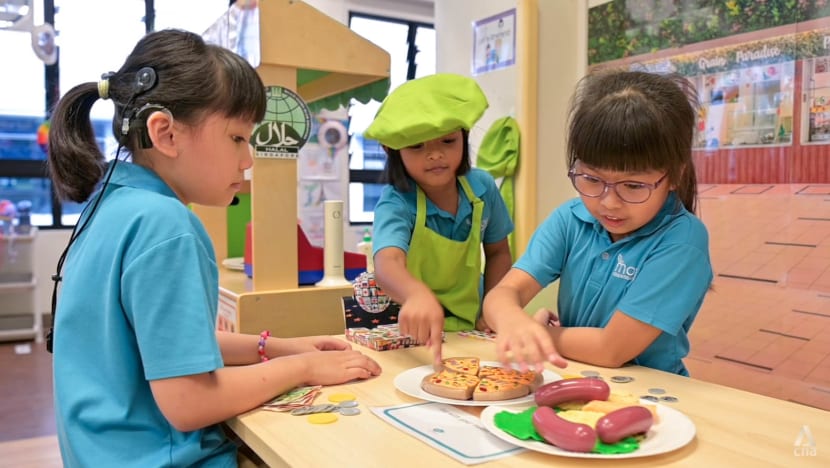
In this classroom, where children with different hearing abilities continue to learn side by side, lessons on inclusion and confidence are learnt daily, without being taught explicitly.
And it is not only the children who have learnt them, but also parents, teachers and even visitors to the kindergarten.
GETTING THE BALL ROLLING
The wheels of this initiative had been set in motion before the kindergarten, located within Mayflower Primary School, began operations in 2021. The MOE announced in November 2020 that the kindergarten would be supporting children with moderate to profound hearing loss from 2022.
When she first heard the news, via an email from the ministry, centre head Melina Chen’s first reaction was excitement. Then she began to worry. “Oh dear,” she recalled. “How are we going to communicate with the children?”
To be sure, the model the kindergarten would follow was not a new one: Mayflower has been the designated primary school for pupils with hearing loss since 2018. They attend classes with their hearing peers, supported by a dedicated signing teacher who communicates the lessons to them in Singapore Sign Language.
WATCH: When 7-year-old deaf and hearing preschoolers learn side by side (18:40)
Chen said she was reassured on this during subsequent visits from ministry representatives who briefed her. But at that point, no one in her team knew sign language or how to interact with children with hearing loss, much less teach them.
Together with her teachers, they began researching how to get the children’s attention, get them to participate in activities, and even the best seating arrangements in the classroom with respect to the line of sight of the teacher.
“We had different groups doing presentations on different things,” she said. “We wanted to be well prepared before we received the children.”
But it needed the kindergarten’s dedicated signing teacher to join the team, in mid-2021, to really get things moving.
Bernadette Pung had been at Mayflower Primary for four years in a similar role and decided to join the kindergarten because of her interest in working with younger children. She remembers that while many of her new colleagues did not know any sign language, they were willing learners.
She arranged for a teacher from Mayflower Primary to come to the kindergarten and talk about deaf culture. The teacher also showed them some daily signs they could use with the children: words like “toilet”, “teacher” and “happy”.
Adaptations to classroom spaces and learning materials were also made. Letters of the alphabet and pictures designating different corners of the classroom were accompanied by their equivalent in sign language.
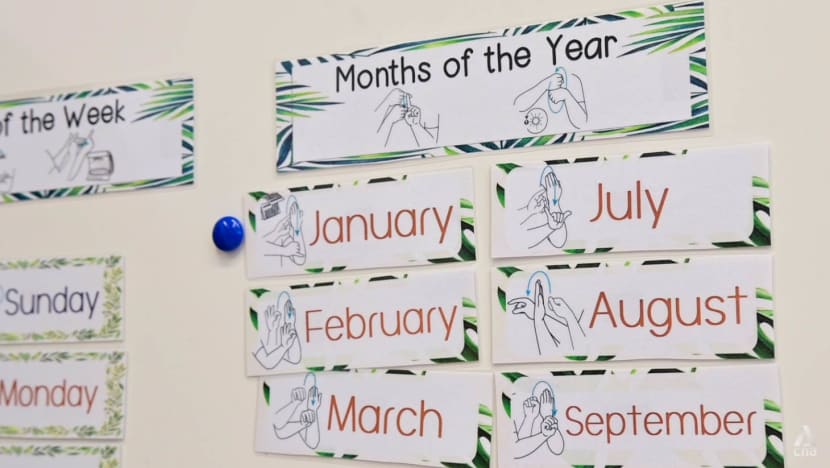
“The children with hearing loss can (use the signs) for a reference check, while the hearing children can learn alongside them,” said Chen.
Even so, she and her team “didn’t know what to expect” when the 2022 school year began and the children came in. “My teachers and I … just (had to) wait and see,” she said.
STARTING K1 WITH NO LANGUAGE
One of those children joining in K1 was Azza, who was previously in an early intervention centre. She was excited to be going to a new school and had practised introducing herself in sign language.
But on her first day, she froze on the spot, recounted her mother, Norasyikin Jaafar. “Maybe because there were so many unfamiliar people in class.”
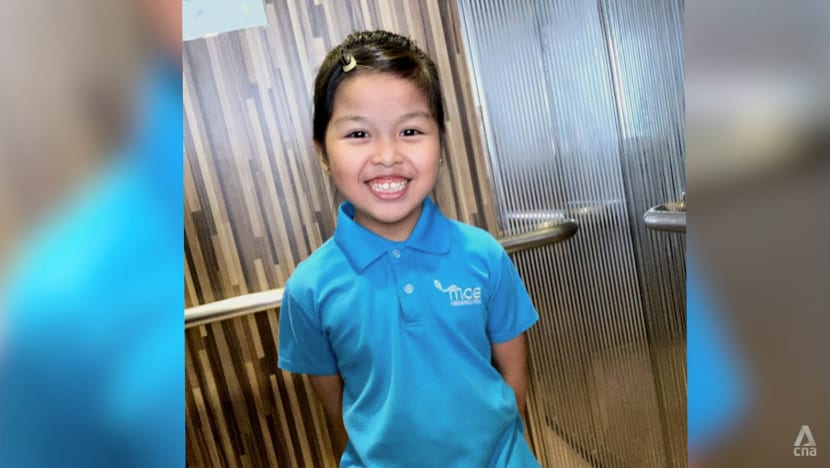
Azza, then 6, already had a head start over the other three children with hearing loss: She was the only one who knew some basic sign language, picked up from her two elder sisters, who also had hearing loss, and her mother, who was learning sign from YouTube videos.
“I had to memorise a lot, and sometimes I’d still forget (the signs),” said Norasyikin. “It was very difficult.”
It is common to see hearing parents of children with hearing loss end up feeling “lost”, according to Pung, because learning to sign “is like learning a completely new language”.
In some cases, parents may be encouraged to try other modes of communication for their child, such as the oral approach, which uses speech, she said. “That’s another difficulty parents may face — being torn between the many different ideas people have.”
Options for pre-school children with moderate to severe hearing loss
Children with moderate to severe hearing loss can attend centres offering the Early Intervention Programme for Infants and Children (Eipic), or Canossaville Preschool, which specialises in supporting children with hearing loss, or the MOE Kindergarten @ Mayflower.
Eipic centres, however, take children with various disabilities and may not have teachers who use sign language, said Barbara D’Cotta, a training manager at the Singapore Association for the Deaf (SADeaf).
Mainstream kindergartens are also an option. But she said the child’s ability to cope depends on his or her circumstances, such as degree of hearing loss, family support available and the pre-school’s ability to cater for the child’s needs.
Learning sign language guarantees the child full access to communication at the earliest possible time. There are also other modes of communication, such as assistive devices (hearing aids or cochlear implants) and use of voice, which may require speech therapy.
There are no drawbacks to exploring all these options, said D’Cotta. The different modes complement each other, and the child can use different modes in different scenarios.
SADeaf also runs a communication programme called the Little Hands Bilingual-Bicultural Programme, which provides early communication and intervention for children with hearing loss. It is not meant, however, to be a substitute for pre-school.
Its bilingual approach — whereby both Singapore Sign Language and English are taught — provides children with a choice between using either language, depending on their hearing skills, environment and what they feel more comfortable using.
Children can start on the programme from the age of two. It prepares the child to acquire Singapore Sign Language and for early reading and writing in English, which are prerequisites for the transition to pre-school.
A termly fee of S$4,000 is charged, but parents who have difficulty paying the fees are referred to SADeaf’s Community Services Department. Social workers will carry out a means test and apply for funding from other organisations.
As a result, children may start kindergarten with “little to no language”, and Pung cited a “significant difference” in language ability between the hearing children and their peers with hearing loss when they began K1.
“Hearing children can communicate and tell us what their name is, what they like or dislike, but the children with hearing loss may not know (how to),” she said. A child with hearing loss might know what a tree is, for example, but not be able to tell people what they saw.
Children with hearing loss also lose out on incidental learning, she added. “You pick up a lot of things from listening to other people’s conversations. But these children don’t.”
PARTICIPATION AND PROGRESS
At the MOE Kindergarten @ Mayflower, each lesson is taught concurrently by the speaking and signing teachers, so the children with hearing loss can learn alongside their peers. Pung also acts as interpreter for them, so they can participate fully in class activities by, for example, answering questions or singing songs.
She said each song is sung twice: once in sign language and the other with actions. This also means the rest of the children in class end up picking up sign language, purely by exposure.
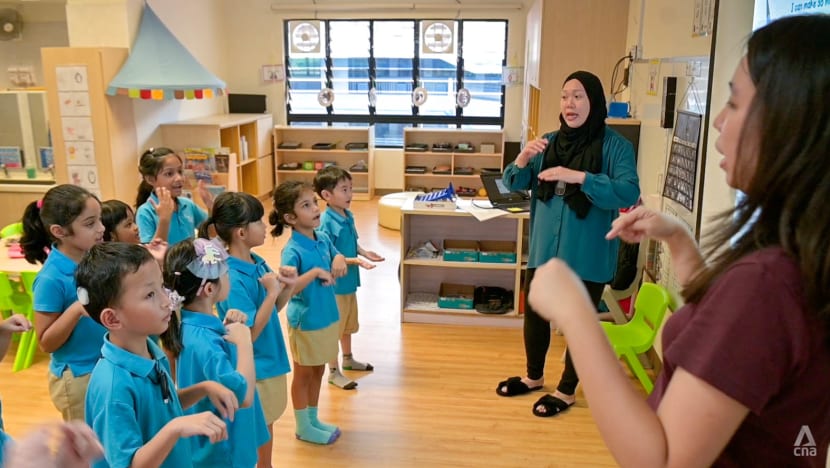
When they go to mother tongue lessons, children with hearing loss will learn Singapore Sign Language in a separate room.
Pung remembers that at the start of K1 for the four children, she communicated with them using simple gestures, such as by mimicking a duck, or showing a picture. As they progressed, she would introduce the relevant sign.
“Teaching them sign language gives them the first language to communicate what they want,” she said. “When the foundation is built, we need to continue building their vocabulary bank so we can teach them … concepts.”
This could take a lot of work on her part, especially when teaching more abstract concepts like kindness. Role-playing helps in instances like this; for example, she could have a child mimic a fall, and ask the others what they could do to help their friend.

As the days went by, she saw improvement as well as the children’s increased confidence. She highlighted Thea in particular, who came in a few months later than her friends.
“You could see she wanted to play with her friends but just didn’t have the language,” Pung recalled.
“But she’d push herself — when she wants to answer a question and her friends try to help her, she’d tell them not to because she wants to think and learn.”
Today, Thea can express her opinion, argue and negotiate with her friends, Pung said with a laugh. “We always say that arguing is a good thing because you have the language to do that.”

Azza, too, has improved by leaps and bounds.
Her mother remembers when she used to watch her sisters signing but not want to participate much. That is no longer the case. “She’s so confident (about) using sign language and talking to me and her sisters” said Norasyikin.
“She’s able to tell me what happens in school and even wanted to teach (sign language) to my friend’s child, which made my friend’s child want to learn sign language.
“I was so impressed that she was confident enough to teach other people using sign language. That made me proud of her.”
Norasyikin gives credit to Azza’s early start and exposure to sign language in her kindergarten, something the two elder sisters — who attended early intervention centres where signing was not taught — did not have.
Her eldest daughter, now 13, started learning sign language only just before she entered Mayflower Primary.
“(Her) primary school teacher told me she was a bit behind in signing,” Norasyikin said. “It was hard for her to learn it at primary school because it was something so new to her.”

STRIKING UP FRIENDSHIPS
The hearing children also benefit.
When they first started K1, the teachers briefed them on how to interact with their peers with hearing loss. “They asked very genuine questions, like what (their classmates) were wearing (next to their ear) and why ‘they can’t hear me when I call them,’” said Pung.
She explained hearing aids to them and suggested they could tap their friends on the shoulder if they wanted to get their attention.
“Kids, being kids, … don’t see the difference in their friends,” said centre head Chen. “The only difference is they know that they need to use sign language to communicate with their friends.”
Indeed, right from the start Pung observed the children playing and learning together “very naturally”.
“Some of them would … ask (me) certain signs so they could, for example, sign to their friend that they wanted to build a castle,” she said. “They slowly learnt that ‘when I sign, my friend understands me, so I continue using (sign).’”
As they progressed to K2, all this came much more naturally to them. Casual conversations between the different children became commonplace as they compared their friendship bracelets, built blocks together and even argued over crayons.
“If you don’t see the (hearing aids), you don’t actually know who has hearing loss and who doesn’t,” said Pung.
This was something mum Sangeetha Sivakumar appreciated when she saw how naturally her daughter, Khariessha Kanan, who is hearing, made friends with the other children.

Sangeetha had found out only during Khariessha’s orientation that there would be children with hearing loss in the class. “I was thrilled,” she recalled. “But I did have some concerns (about) whether she’d be able to communicate — would she be able to show kindness and patience or be confused or frustrated?
“Then I realised that nothing could help her prepare for it until she was in that environment.”
By the end of the second week, Khariessha would come home and try to teach her parents the sign language she had picked up. She refers to her “sign language friends” in a “matter-of-fact way”, and they are part of her group of friends in class, said her mother.
“(Being in this class) has helped her be more expressive and pay a bit more attention to other people when it comes to their hand gestures, facial expressions and body language,” said Sangeetha.
“When she (is in) environments where she’s not familiar with other kids, she usually takes the first step (and asks them) if they’d like to play with her.
“It could’ve been sparked off by how (she’s) able to play together with different children in the same classroom.”
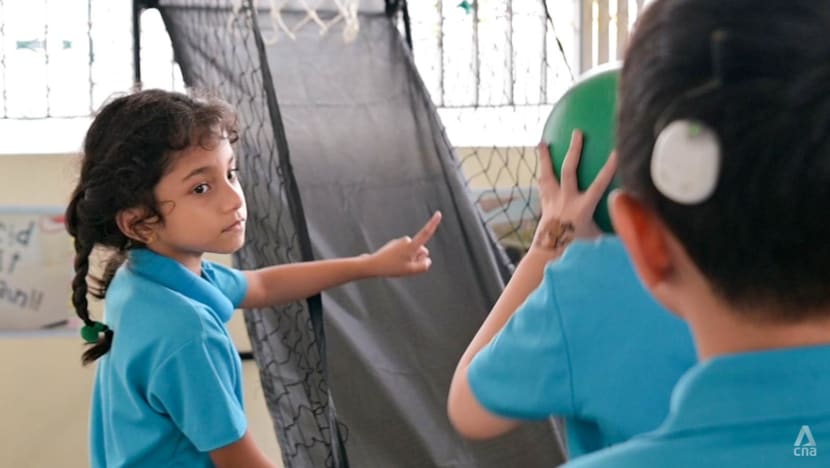
Classroom visitors, too, have expressed surprise at how naturally the children interact with each other. “They’d say things like, ‘Wow, I can’t tell the difference,’” said Pung.
She believes these observations come about because of a lack of awareness or direct exposure to people with hearing loss.
“When (people) see someone or a child having a disability, they may feel (that) maybe that child can’t do (certain things), but actually (children) can learn and play together, if given the support in the classroom,” she said.
NO LONGER JUST SAYING ‘GOOD’
The kindergarten teachers, too, have grown over the past two years.
When the children with hearing loss first started K1, Chen was “very quiet” and hesitant to use the simple signs she had learnt. “Everything was just ‘good, good, good,’” she said, making the thumbs-up sign.
As the weeks went by, she realised that if she were to sign to the children more, their confidence would grow as well. “The children feel good because I’m speaking their language,” she said.
When you go to a country that speaks a different language, and you find someone who can speak your language, how do you feel? Of course I’d feel at home. I’d feel more confident (about asking) things.”
In mid-2022, Chen and some of her teachers went on a Singapore Sign Language course conducted by the Singapore Association for the Deaf, which spanned 24 hours, to build their vocabulary and confidence.
It was done in their own time, on weeknights or at weekends.
Since then, all the kindergarten’s teachers have completed the course, and many of them have chosen to go on to the next level of the course. Chen herself has completed the third level.
“Instead of just saying ‘good’, I can say things like, ‘It’s nice’, ‘I like it’, and so on,” she said.
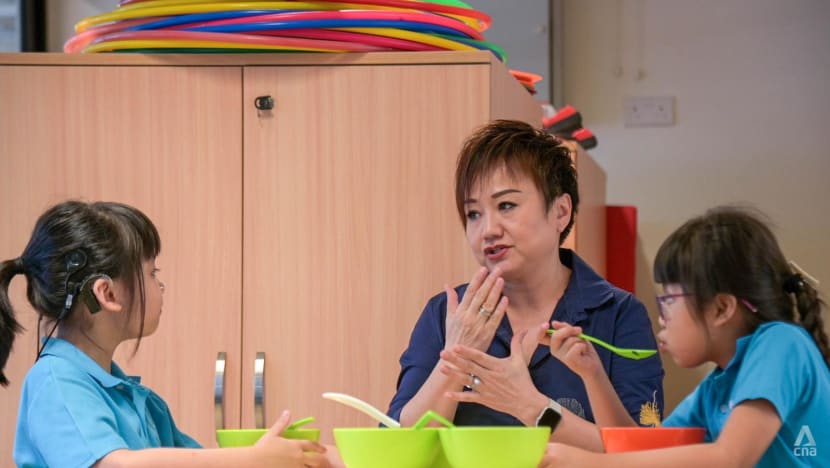
Ivy Tham, who teaches the K2 pupils, together with Pung, also highlighted the benefits of doing the course.
“Initially, I relied very heavily on Bernadette, and I’d feel worried and lost if she had to go off for breaks,” she said. “Now that I’m able to communicate better with the children, I feel that they’re closer to me.
“They’ll come over and tell me what they did over the weekend or what they’ve eaten for lunch.”
Chen can see the difference it has made to her teachers. “When they sign to the children, … the satisfaction is there (on their faces),” she said.
Nonetheless, both Tham and Chen highlighted the need for constant practice to maintain their fluency. Every now and then, Chen sits in on Pung’s Singapore Sign Language lessons for the children to familiarise herself with the signs.
Things remain a work in progress. Chen and her team are constantly seeing how they can make adaptations to their practices and learning spaces to better support the children.
A recent modification to the kindergarten’s outdoor play area, once set up with different-coloured shapes on the walls and the floor to encourage the children to play Twister, involved the addition of two spinners labelled with signs.
The spinners were added after teachers realised the children with hearing loss could not participate in the game, as they could not name the colours and shapes out loud.
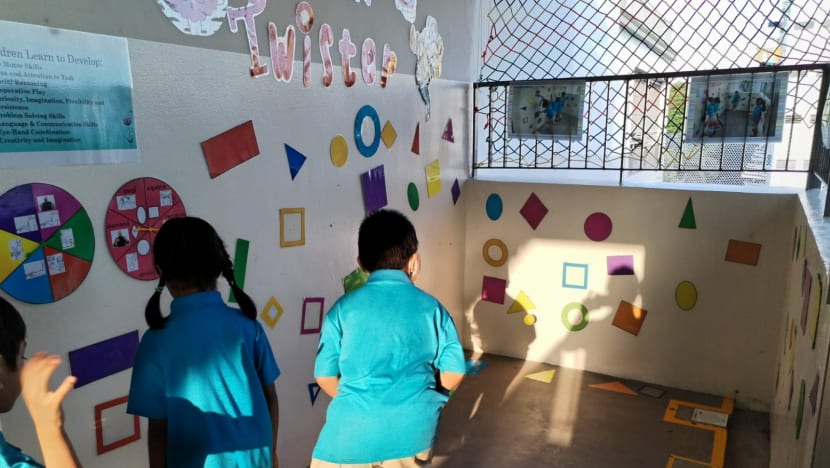
READY, SET, GONE TO PRIMARY 1
The question now is, how ready are the children for primary school?
To help with the transition, the kindergarten arranged for them to visit the adjoining Mayflower Primary, where they were paired up with buddies and got to sit in on a class.
But for most if not all the children, the highlight of the day was visiting the canteen and buying food, with help from their buddies.
Azza and Thea, now best friends and never far away from each other, beamed from ear to ear as they sat at a table eating their food. They signed to each other furtively as Pung, who was sitting nearby, observed them.
“They don’t want me to see what they’re signing,” she said with a smile.
Her smile broadened when she saw Thea signing to her Primary 6 buddy, who also has hearing loss. “She’s saying that she wants to come back to the canteen again,” said Pung.
%20_0640.MP4_.00_00_13_05.Still001.jpg?itok=jg4oSfk8)
It was clear to Pung that the first batch of children with hearing loss to graduate from the kindergarten were brimming with confidence — and ready for their next stage of life, at Mayflower Primary, where they can benefit from the same teaching model as the kindergarten.
“I’ll definitely miss them,” she said. “But I hope they’ll continue to be brave and confident as they go on to Primary 1.”
When asked if the programme will be extended to other MOE Kindergartens (MKs), the ministry said the number of children in Singapore diagnosed with moderate to severe hearing loss who require signing is expected to remain low.
“MOE considers factors such as demand for the programme and the availability of MK teachers with signing competencies,” said a spokesperson. “Similar factors are also taken into consideration when deciding whether to implement specialised programmes for children with other special educational needs.”
The ministry added that children with mild hearing loss can be supported in other MKs with assistive technology like hearing aids.
R0001401.jpg?itok=UND6iHAD)
Back at the Mayflower kindergarten, two children with hearing loss have started K1 in the new school year.
As Pung sees it, there is plenty of work to be done to equip them with the skills and language they need to do well, not only at primary school but in life.
It is their perseverance and willingness to learn that “really keeps me going”, she said. “I definitely have to be there to support and teach them.”



















